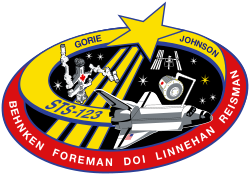Takao Doi
| Takao Doi (土井隆雄) | |
 Takao Doi | |
| Född | 18 september 1954 Tokyo, Japan |
|---|---|
| Tid i rymden | 31 dagar, 19 timmar, 35 minuter |
| Uppdrag | STS-87, STS-123 |
| Uppdragsemblem | |
Takao Doi (japanska: 土井隆雄), född 18 september 1954 i Minamitama-gun[1], är en japansk astronaut.
Asteroiden 4746 Doi är uppkallad efter honom.[2]
Rymdfärder
Referenser
- ^ Astronaut Takao Doi's Profile. JAXA Space Station. Läst 10 september 2013.
- ^ ”Minor Planet Center 4746 Doi” (på engelska). Minor Planet Center. https://www.minorplanetcenter.net/db_search/show_object?object_id=4746. Läst 13 maj 2019.
|
Media som används på denna webbplats
The STS-87 patch is shaped like a space helmet symbolizing the Extravehicular Activity (EVA) on the mission in support of testing of tools for the assembly of the International Space Station (ISS). Earth is shown reflected on the backside of the helmet. The Space Shuttle Columbia forms the interface between the Earth and the heavens, the back and front sides of the helmet in profile. The three red lines emerging from Columbia represent the astronaut symbol as well as the robot arm, which was used to deploy and retrieve the Spartan satellite.
The text 'µg' represents the payloads studying microgravity science in space on this United States Microgravity Payload (USMP-4) mission. Gold flames outlining the helmet visor represent the corona of the Sun, which will be studied by Spartan. The flag of Ukraine is next to the name of the payload specialist who is the first person from that nation to fly on the Space Shuttle.
STS-123 continues assembly of the International Space Station (ISS). The primary mission objectives include rotating an expedition crew member and installing both the first component of the Japanese Experimental Module (the Experimental Logistics Module - Pressurized Section (ELM-PS)) and the Canadian Special Purpose Dexterous Manipulator (SPDM). In addition, STS-123 will deliver various spare ISS components and leave behind the sensor boom used for inspecting the shuttle's thermal protection system. A follow-on mission to ISS will utilize and then return home with this sensor boom. A total of five spacewalks are planned to accomplish these tasks. The mission will also require the use of both the shuttle and ISS robotic arms. STS-123 will utilize the Station-Shuttle Power Transfer System to extend the docked portion of the mission to eleven days, with a total planned duration of 15 days. The crew patch depicts the space shuttle in orbit with the crew names trailing behind. STS-123's major additions to ISS (the ELM-PS installation with the shuttle robotic arm and the fully constructed SPDM) are both illustrated. The ISS is shown in the configuration that the STS-123 crew will encounter when they arrive.


